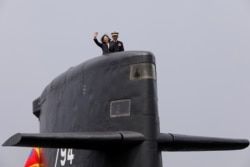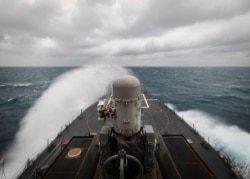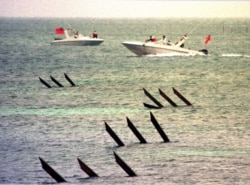The United States has doubled its unofficial military presence in Taiwan over the past year in what specialists describe as the latest signal to China that Taiwan's future remains a priority.
The increase from 20 personnel to 39 between December 31 and September 30 came with little fanfare, but it did coincide with a rare public acknowledgement by President Tsai Ing-wen in October that the U.S. military maintains a small presence in Taiwan.
Active-duty deployments now include 29 Marines as well as two service members from the Army, three from the Navy and five from the Air Force, according to the Pentagon's Defense Manpower Data Center.
While the United States has not disclosed what the military personnel are doing, at the very least it is sending a strong signal to China, said Kitsch Liao, military and cyber affairs consultant for DoubleThink Lab, a Taiwan-based research organization specializing in disinformation.
"The escalation is subtle but unmistakable," he told VOA.
It is unclear whether these figures include a U.S. special operations contingent and Marines who are in Taiwan to train the local military or whether they are officers involved in planning and State Department operations.
Their presence was confirmed in late October by President Tsai after The Wall Street Journal published two stories stating they had been in Taiwan for at least a year, citing unnamed U.S. officials.
The U.S. Defense Department has no comment on the troops' presence but the U.S. Army published rare photos late last year of U.S. Green Berets training with Taiwanese soldiers.
They were also the subject of a Taiwan News report last year, although at the time both U.S. and Taiwanese officials appeared to deny their presence.
The U.S. stationed thousands of troops in Taiwan from the 1950s through the 1970s following the first Taiwan Strait crisis in 1954, but they began to depart in 1972 after the United States and China signed the Shanghai Communique and began to normalize relations.
After the United States formally broke off relations with Taiwan in 1979, only a small number of Marines have remained attached to the American Institute in Taiwan, the unofficial U.S. embassy.
"The presence of U.S. military, if ever confirmed officially, is sort of testing China's red line since one of the major stipulations for the initial U.S.-China rapprochement back in the 1970s was that the U.S. must withdraw forces from Taiwan on top of switching recognition," Liao said.
In the communique, the United States declared it had an "interest in a peaceful settlement of the Taiwan question by the Chinese themselves," and pledged a total withdrawal from Taiwan as an "ultimate objective."
He described the current situation as an "escalation that can easily be de-escalated without much cost in credibility."
China is in a major military modernization campaign, due to finish by 2035. But it may have the capacity to launch a "credible" military operation against Taiwan, which it claims as a wayward province, as early as 2027, according to a new Pentagon report.
Relations between Taipei and Beijing have soured since the election of President Tsai, whom the Chinese media portray as a "separatist" because her political party does not endorse eventual unification with China.
As tensions in the Taiwan Strait have escalated in the past year, U.S. President Joe Biden has indicated the U.S. will "support" Taiwan if it is attacked, although formal U.S. policy is more ambiguous and stops short of promising to defend Taiwan. The 1979 Taiwan Relations Act states that the United States will "make available to Taiwan such defense articles and defense services" to allow it to defend itself from attack, language Washington has implemented through large weapons sales.
Biden's comments have also been walked back by White House officials; however, the U.S. is not the only country that has hinted its support.
Former Japanese Prime Minister Shinzo Abe said this week that Japan and the United States could not "stand by" if China attacked Taiwan. Australia's government also has suggested it would do the same after announcing the AUKUS trilateral security pact with the United States and United Kingdom in mid-September.
"The U.S. is showing its support for Taiwan in an 'American salami-slicing way' by repeated visits by U.S. congressional members and other high-profile figures," said Bill Sharp, who writes about Taiwanese history and defense and was a visiting scholar at National Taiwan University in 2020.
In the last 1½ years, he said, "we have sold one arms package after another to Taiwan."
"Trying to be as low-key as possible given the continued [Chinese] threat to Taiwan, we are letting [China] clearly know that the security of Taiwan is crucially important to the US," he said by email.
Additional U.S. military personnel might be in Taiwan to show members of the Taiwanese military how to use their latest weapons purchases, Sharp said, or to train them in small rubber boat tactics to help defend outlying islands such as the Pratas Islands.
The uninhabited islands are administered by Taiwan but lie close to continental Asia and Chinese military bases on Hainan Island, making them an easy target for Beijing. They are also of strategic value as they lie at the entry and exit of the Bashi Channel and the Taiwan Strait, which could give China access to the Western Pacific.
Attacking the island could be a convenient way to "embarrass" Taiwan and the United States without civilian loss of life, Sharp said.
"I am willing to wager that at least a few US service personnel are on Pratas to train the Taiwan defenders and to serve as a 'trip wire.'That is insurance that the PRC will not attack Pratas which could result in an American death putting greater strain on the US-China relations."
VOA's Jeff Seldin contributed to this report.













